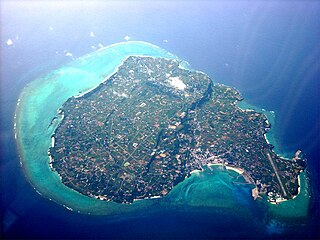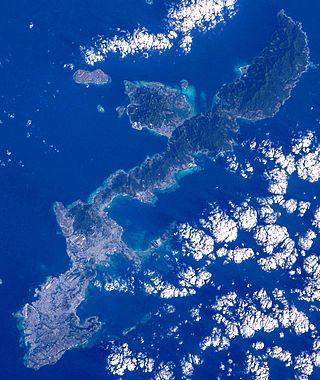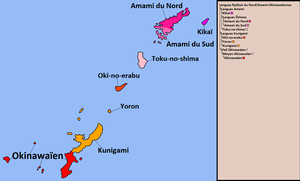
Okinawan, more precisely Central Okinawan, is a Northern Ryukyuan language spoken primarily in the southern half of the island of Okinawa, as well as in the surrounding islands of Kerama, Kumejima, Tonaki, Aguni and a number of smaller peripheral islands. Central Okinawan distinguishes itself from the speech of Northern Okinawa, which is classified independently as the Kunigami language. Both languages are listed by UNESCO as endangered.

Japonic or Japanese–Ryukyuan, sometimes also Japanic, is a language family comprising Japanese, spoken in the main islands of Japan, and the Ryukyuan languages, spoken in the Ryukyu Islands. The family is universally accepted by linguists, and significant progress has been made in reconstructing the proto-language, Proto-Japonic. The reconstruction implies a split between all dialects of Japanese and all Ryukyuan varieties, probably before the 7th century. The Hachijō language, spoken on the Izu Islands, is also included, but its position within the family is unclear.

The Ryukyuan languages, also Lewchewan or Luchuan, are the indigenous languages of the Ryukyu Islands, the southernmost part of the Japanese archipelago. Along with the Japanese language and the Hachijō language, they make up the Japonic language family.

The Amami language or languages, also known as Amami Ōshima or simply Ōshima, is a Ryukyuan language spoken in the Amami Islands south of Kyūshū. The southern variety of the Setouchi township may be a distinct language more closely related to Okinawan than it is to northern Ōshima.

The Amami Islands is an archipelago in the Satsunan Islands, which is part of the Ryukyu Islands, and is southwest of Kyushu. Administratively, the group belongs to Kagoshima Prefecture, Japan. The Geospatial Information Authority of Japan and the Japan Coast Guard agreed on February 15, 2010, to use the name of Amami-guntō (奄美群島) for the Amami Islands. Prior to that, Amami-shotō (奄美諸島) was also used. The name of Amami is probably cognate with Amamikyu (阿摩美久), the goddess of creation in the Ryukyuan creation myth.

Tokunoshima, also known in English as Tokuno Island, is an island in the Amami archipelago of the southern Satsunan Islands of Kagoshima Prefecture, Japan.

Kunigami or Northern Okinawan is a Ryukyuan language of Northern Okinawa Island in Kunigami District and city of Nago, otherwise known as the Yanbaru region, historically the territory of the kingdom of Hokuzan.

The Ryukyu Islands, also known as the Nansei Islands or the Ryukyu Arc, are a chain of Japanese islands that stretch southwest from Kyushu to Taiwan: the Ryukyu Islands are divided into the Satsunan Islands and Okinawa Prefecture. The larger ones are mostly volcanic islands and the smaller mostly coral. The largest is Okinawa Island.

Kikaijima is one of the Satsunan Islands, classed with the Amami archipelago between Kyūshū and Okinawa.

Yoronjima, also known as Yoron, is one of the Amami Islands.
As Japanese citizens, people of the Amami Islands presently only have family names (surnames) and given names. They are known for many unique one-character surnames that date back to the Edo period. A survey on telephone directories of 2002 shows that 21.5% of the residents of the Amami Islands have one-character surnames. Famous people with one-character surnames include Atari (中) Kōsuke, Hajime (元) Chitose and Nobori (昇) Shomu.
The Kikai language is spoken on Kikai Island, Kagoshima Prefecture of southwestern Japan. It is debated whether it is a single dialect cluster. Regardless, all Kikai dialects are members of the Amami–Okinawan languages, which are part of the Japonic languages.
Kamuiyaki ware (カムィヤキ), from Tokunoshima kamïyaki, is grey stoneware produced in Tokunoshima, the Amami Islands, Kagoshima Prefecture, Japan, from the 11th century to the early 14th century, or from the late Heian period to the Kamakura period.
The Amami languages are a collection of dialect clusters spoken across the Amami Islands of Kagoshima Prefecture, Japan. All dialects are members of the Ryukyuan languages, specifically its northern branch.
The Tokunoshima language, also Toku-no-Shima, is a dialect cluster spoken on Tokunoshima, Kagoshima Prefecture of southwestern Japan. It is part of the Amami–Okinawan languages, which are part of the Japonic languages.
The Okinoerabu dialect cluster, also Oki-no-Erabu, is a dialect cluster spoken on Okinoerabu Island, Kagoshima Prefecture of southwestern Japan. It is part of the Amami–Okinawan languages, which are part of the Japonic languages.

Amami Guntō National Park is a national park in Kagoshima Prefecture, Japan. Established in 2017, the park comprises a land area of 42,181 ha and a sea area of 33,082 ha. The national park includes areas of these islands: Tokunoshima, Kikai, Amami, Yoron, Okinoerabujima, Uke Island, Kakeromajima and Yoroshima.

Okinawa (沖縄) is a name with multiple referents. The endonym refers to Okinawa Island in southwestern Japan. Today it can cover some surrounding islands and, more importantly, can refer to Okinawa Prefecture, a much larger administrative division of Japan, although the people from the Miyako and Yaeyama Islands still feel a strong sense of otherness to Okinawa.
Amami Japanese is a variety of the Japanese language spoken on the island of Amami Ōshima. Its native term Ton-futsūgo means "potato standard". Much like Okinawan Japanese, it is a descendant of Standard Japanese but with influences from the traditional Ryukyuan languages.
Ryukyuan culture are the cultural elements of the indigenous Ryukyuan people, an ethnic group native to Okinawa Prefecture and parts of Kagoshima Prefecture in southwestern Japan.












